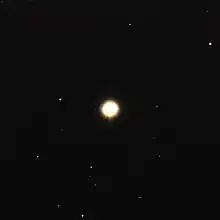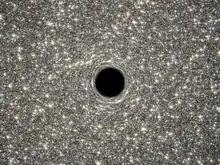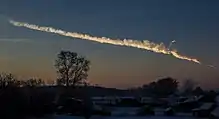M60-UCD1
M60-UCD1 is an ultracompact dwarf galaxy. It is 54 million light years from Earth, close to Messier 60 (M60, NGC 4649) in the Virgo Cluster. Half of its stellar mass is in the central sphere 160 light years in diameter.[2]
| M60-UCD1 | |
|---|---|
 A picture of M60-UCD1 taken by the Hubble Space Telescope Credit: NASA, ESA, CXC, and J. Strader (Michigan State University) | |
| Observation data (J2000 epoch) | |
| Constellation | Virgo |
| Right ascension | 12h 43m 35.976s[1] |
| Declination | 0h 46m 8.328s[1] |
| Helio radial velocity | 1290 ± 5 km/s[1] |
| Distance | 54 Mly (16.5 Mpc)[1] |
| Absolute magnitude (V) | 14.2[1] |
| Characteristics | |
| Size | 158 ± 3 ly (diameter) (24.2 ± 0.5 pc half-light radius)[1] |
Characteristics

M60-UCD1's mass is 140 million solar masses. Colours and lack of colour gradients indicate a uniform stellar population about 14.5±0.5 billion years old [1] [4] (indistinguishable from the age of the Universe). Their metallicity is similar to that of the Sun. The orbital velocity dispersion of the innermost stars exceeds 100 km/s,[4] due to the gravity of a dense mass concentration. The galactic nucleus contains a bright and variable X-ray source,[1] presumably a supermassive black hole with a mass of 20 million solar masses (15% of the mass of the entire galaxy).[5] With this proportion of the mass of the black hole to that of the whole galaxy, it is one of the most black hole dominated galaxies known.[6]
M60-UCD1 is believed to be the stripped core of a much more massive galaxy, whose mass was stripped in an encounter with M60 some 10 billion years ago. It may yet be absorbed completely by M60, its central black hole merging with M60's as well. The galaxy may have once had some 10 billion stars.[6]
As of 2013, it is possibly the densest known galaxy with over one hundred stars per cubic light-year.[7] As of 2014, it is the smallest and least massive galaxy known to host a central black hole. It was previously known as the most massive ultracompact dwarf galaxy known.[6]
See also
- M85-HCC1 (densest galaxy known, as of 2015)
References
- Strader, J.; et al. (2013). "The Densest Galaxy". The Astrophysical Journal. 775: L6. arXiv:1307.7707. Bibcode:2013ApJ...775L...6S. doi:10.1088/2041-8205/775/1/L6.
- "Astronomers Discover Densest Galaxy Ever". ScienceDaily. Retrieved 26 September 2013.
- "Big surprises can come in small packages". www.spacetelescope.org. ESA/Hubble. Retrieved 22 September 2014.
- Seth, A.; et al. (2014). "A Supermassive Black Hole in an Ultracompact Dwarf Galaxy". Nature. 513: 398–400. arXiv:1409.4769. Bibcode:2014Natur.513..398S. doi:10.1038/nature13762.
- "M60-UCD1: An Ultra-Compact Dwarf Galaxy". NASA. Retrieved 25 September 2013.
- "Smallest known galaxy with a supermassive black hole". ScienceNews. 17 September 2014.
- "Evidence for densest galaxy in nearby universe". Phys.org. 24 September 2013. Retrieved 25 September 2013.
Further reading
- Strader, Jay; Seth, Anil C.; Forbes, Duncan A.; Fabbiano, Giuseppina; Romanowsky, Aaron J.; Brodie, Jean P.; Conroy, Charlie; Caldwell, Nelson; Pota, Vincenzo; Usher, Christopher; Arnold, Jacob A.; "The Densest Galaxy", The Astrophysical Journal Letters, Volume 775, Issue 1, article id. L6, 6 pp., September 2013; doi:10.1088/2041-8205/775/1/L6; arXiv:1307.7707; Bibcode:2013ApJ...775L...6S
- Seth, Anil; van den Bosch, Remco; Mieske, Steffen; Baumgardt, Holger; den Brok, Mark; Strader, Jay; Neumayer, Nadine; Chilingarian, Igor; Hilker, Michael; McDermid, Richard; Brodie, Jean; Frank, Matthias; Walsh, Jonelle L.; "A Supermassive Black Hole in an Ultracompact Dwarf Galaxy", Nature, 513, pages 398–400, 18 September 2014; doi:10.1038/nature13762; arXiv:1409.4769; Bibcode:2014arXiv1409.4769S
External links
- Chandra X-Ray Observatory, "NASA's Hubble and Chandra Find Evidence for Densest Nearby Galaxy", NASA, 24 September 2013
- ScienceDaily, "Evidence for Densest Nearby Galaxy", 24 September 2013
- ScienceDaily, "Astronomers Discover Densest Galaxy Ever", 24 September 2013
- NASA Astronomy Picture of the Day: The Densest Galaxy (October 4, 2013)


